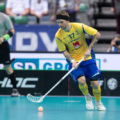You can only win a floorball game by scoring at least once, but actually: the more, the better. Usually, it’s the forwards that score the goals, although of course, this is not always the case.
Featured image from Per Wiklund.
By the end of this bootcamp, I will have given you all the tools so you can start your journey to become a complete forward. This means that you will be able to score more goals, know what to do when you lose the ball, what to do when you’re defending and we’ll also pass you some tips from some of world’s best players (in part 2).
To make things easier, I have divided the bootcamp in 2 parts each consisting of 2 chapters. These chapters more or less correspond with your general tasks as a floorball foward:
Chapter 1: If your team is in possession of the ball. You try to create space and depth in order to increase your chances of scoring a goal.
Chapter 2: When the team is not in possession. You are the first line of defense and try to keep the opponent on his own half as much as possible.
Chapter 3: The changes between possession and loss of the ball or vice versa. What are the standard patterns you can follow when losing the ball or when your team conquers the ball?
Chapter 4: Jan Zaugg, Joonas Pylsy, and Albin Sjögren speaking. These three top forwards tell us about their thinking during a floorball game.
Let’s waste no more time!
Chapter 1: Ball possession
If your team is in possession of the ball, you can build up an attack and create chances to score. In this chapter, we will talk about what to do when your team is in ball possession and how to set up a playing system properly. Let’s use an example: your team has received a free ball in their own corner and a new line enters the field.
As a forward, you can now try to make the field ‘long’ by running all the way to the opponent’s goal. A defender will have to walk with you, creating more space for your team to build up the attack on the rest of the pitch. In case the defender won’t follow you all the way to the goal, then a high ball can be sent your way, giving you a life-size chance of scoring.
So when your team is in possession of the ball, it is one of the key points as a forward to be in motion. You can make a longitudinal movement, i.e. towards your opponents’ goal and back to the centerline, or a transverse movement, i.e. parallel to the centerline. The goal is to get the opponent out of position and to give your teammates an option to move towards.
Partly, your plan depends on the team’s tactics. If you play in an offensive 1-3-1 system and you are the ‘highest’ forward, then you are regularly at the opponent’s goal. However, if you are one of the forwards of the ‘3’ (from 1-3-1), then you are more at the center line and act as an option to pass to. So discuss this within your line and team. A tip: consult with your fellow forwards about which player is the ‘runner-by-default’, meaning: when starting a counter, it’s good if everyone knows it’s player A who immediately draws a sprint towards the opponent’s goal.
As forward in this case you never stand still (for a long time). You don’t have to sprint non-stop, but make sure you’re always on the move. Sometimes you can sprint, sometimes you can ‘run slowly’, but either way, movement means that your opponent has to focus on you and therefore has less eye for the ball and your team-mates. So force your direct opponent to keep an eye on you.
Have you pulled a sprint towards the goal, but still you find yourself unable to receive the ball? No problem – as long as you can distract at least one opponent you’re doing fine! After a few seconds, you may be able to drop back towards the centerline, but then one of the other forwards will have to move up forward to keep the field ‘long’.
Moving in the width of the field can also be crucial in the search for goals. A perfect example of this is given in our article on the Royal Road, where the goalkeeper is forced to move:
It is crucial for the deepest player to shield the goalkeeper well, be ready for a rebound and always be prepared to shoot.
With this, we have discussed what you can do as a forward when your team is in possession of the ball, but not yet what you should do if you are the one who has the ball. Let’s dig a little deeper into that!
The choices you make in the field usually depend on your positioning. When writing this piece, I’m assuming that you’re on the half of the opponent. No goals equals no victories, so as a forward you have to focus on scoring. To make it more clear, I give a 3-way plan while ball possession:
1. Shoot; 2. Pass; 3. Action.
Huh?
I’ll explain:
1. Shoot
As a forward, your goal is to score. If you’re in a position to shoot, do so. I often see a kind of doubt among players when they are in a promising position, ‘do I have to shoot now, or do I have to pass?’. The answer is 9 times out of 10: you have to shoot!
[ppp_non_patron_only]As much as we love floorball, we dedicate a lot of time and money to the FloorballToday project (more info here). That's why we ask you for a small monthly donation. By clicking the button below you can become one of our supporters and read the rest of the article. Thanks a lot! Already a patron? Then here is where you can login. [/ppp_non_patron_only][ppp_patron_only level="6" silent="no"][ppp_patron_only level=”6″ silent=”no”]
How can you practice this? I give two tips that worked well for me. The first is to ask your goalkeeper for help during practice. Ask him or her to shout ‘Shoot!’ loudly at every possible ‘shooting moment’, so you’ll be trained in recognizing moments to shoot. The goalkeeper can see this best, as he needs to prepare for possible shots.
The other option is to ask a team-mate on the side to do the same. During a break, he or she can tell you the moments at which you could (or should) have taken a shot, and the moments at which you would have been better off opting for Option 2.
2. Pass
If option 1 turns out not to be feasible, we move on to option 2. Why would option 1 not be feasible? This is the case, for example, if an opponent pushes against you, you are too far away from the goal, or if a couple of opponents turn out to be in the trajectory of the shot.
Keep your head in the game: Alexander Galante Carlström also chooses his moments. He shoots when he can, but chooses option 2 when he has to.
Option 2 is the pass. If you cannot shoot yourself, there is a chance that a fellow player will be able to shoot. Passing also means that you remain in possession of the ball, while a shot without a chance often causes you to lose the ball. Cherish possession of the ball, as this forces the opponent to react and ensures that your team has and keeps the initiative
3. Action: make your move
There’s no way to shoot, and you can’t pass either? Then it’s time for option 3: the action, or making your move. An example of such a moment is the counter, where you are the only player of your team on half of the opponent. Passing back is difficult, you’re still too far away from the goal to shoot, so you choose option 3.
Goals that result from an action are often the most beautiful thing to see, but there are many failures that precede it. So you only choose an action when there are no further solutions. If, after performing an action, you have created space for yourself to shoot, do so immediately. However, was your move unsuccessfully (meaning: no space for the shot), but are you still in possession of the ball? Try to opt for the pass again, as there might have opened up some space for it. Your fellow player will probably have more overview, so your team can restart the game and increase the chance of winning the goal again.
General advice when in possession is that you should be and remain in motion. This can mean running across half the pitch, but it can also mean running two meters to the left, then to the right, forwards or backward. The aim of this movement is for your direct opponent to reposition themselves again and again. If you are standing still, you are an easier target, but if you are moving, your opponent runs the risk of being played out as soon as he approaches you. Practice your ball control in particular and ensure that you can keep the ball on the stick without having to constantly look at it.
Chapter 2: The opponent has the ball
If the team is not in possession of the ball, you are naturally involved in defending. As forwards, you are, as it were, the first line of defense. You try to keep the opponent as far as possible on his own half or to lead him to the side of the boarding You can read more about this in the article about the dice five:
READ – Dice five: 2-1-2 in floorball defense
Also in a defensive sense, it is important to understand your team’s system. Do you play in a 2-1-2 in defense, do you play 2-2-1 or do you choose a different variant (such as the W system that resembles a kind of ‘pulled out’ 2-1-2 system)? In all cases, the main goal is to deny your opponent a big chance. So the slot – the space in front of your own goal – must be well shielded; here the opponent must never get into possession of the ball!
In a 2-1-2 system, the two front forwards already start with this: they keep the route over the axis of the field (the imaginary line between the two goals) closed and make sure that the opponent cannot move forward, or can only move forward through the side of the field.
As said, the goal is to keep the opponent from scoring. This does not mean that it is necessary to take the ball as quickly as possible. Sometimes, it’s okay to not have the ball and stay in defense for some time, even if it takes a minute or more to regain possession of the ball. As long as your opponent does not come to a shot, there is not much going on. If the opponent is in possession of the ball, goal #1 is: make sure the opponent cannot shoot.
Are you able to hold on to this goal? Then we can take it one step further. If you’re in a defensive position, the opponent can’t make a shot. It’s now time to try to get back in possession of the ball, because this has to be done in order to score. This can happen if the opponent makes a mistake, such as a wrong pass or a shot against a player.
Often such errors occur because players are put under pressure. This shortens their reaction time and prevents them from choosing the best option. You play an important role in this as a forward.
If there is the possibility to increase the pressure on the opponent, feel free to do so (provided you stick to the rule explained above: don’t allow the opponent to shoot). Do not run like a madlad at the player with the ball, as you are likely to be (easily) passed out, giving the opponent a great chance of scoring. A better alternative is to slowly try to capture the opponent with the ball.
How do you do this?
Imagine the opponent trying to build up with two defenders, one on the left and one on the right. If you are the top forward, you can stand between them so that they can no longer pass to each other. This will force the player in possession of the ball to move forward – which you are forcing him to do. In the meantime, you can also come closer to the ball (while still keeping the pass line shielded) in order to put 2 (you and a teammate) to 1 (the opponent) pressure.
Another example is hitting as soon as the opponent is temporarily ‘weakened’, e.g. when a pass does not arrive well or is poorly accepted. Wait patiently for your chance, as long as you stick to goal #1 – make sure the opponent doesn’t have a possibility to shoot – there is no rush.
Goal #2 is: try to put pressure on the opponent, in order to force him to make a mistake.
Floorball is a sport where you attack and defend together. If you don’t help in the defense as a forward, you put your teammates in a shorthanded 5-vs-4 situation, which greatly increases the chances of your opponent scoring a goal. So always try to keep both goals in mind: make sure the opponent doesn’t get a big chance, and try to put pressure on the opponent if possible to force him to make a mistake.
This was the end of part 1! In the next part we discuss what to do when you retrieve or lose the ball and we share tips from world-class forwards Joonas Pylsy, Jan Zaugg and Albin Sjögren!
[/ppp_patron_only]









No Comments
Leave a comment Cancel